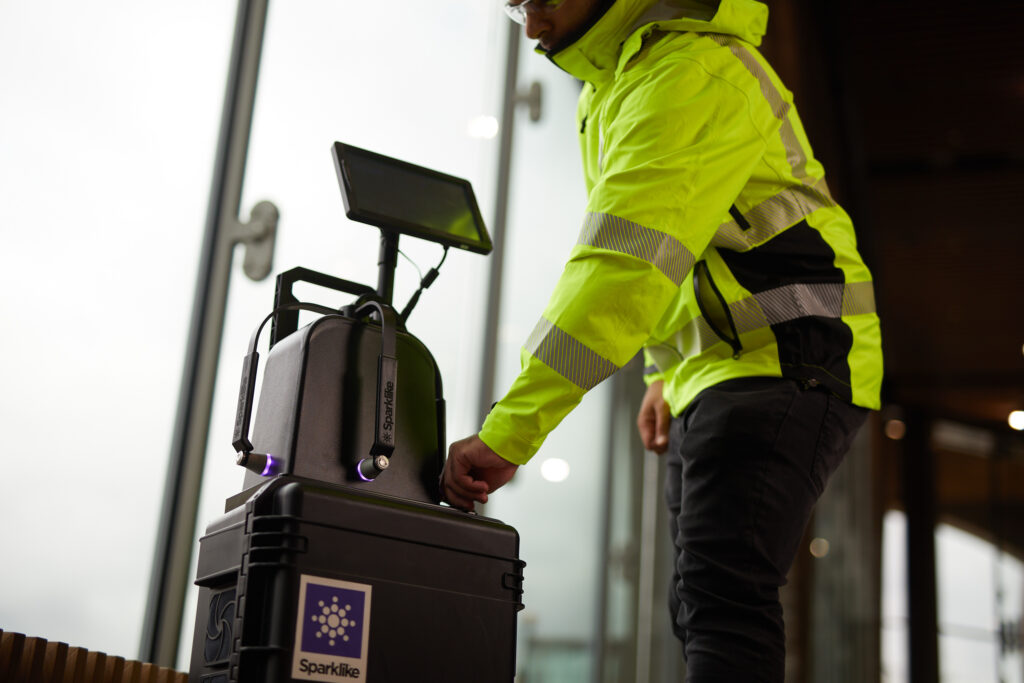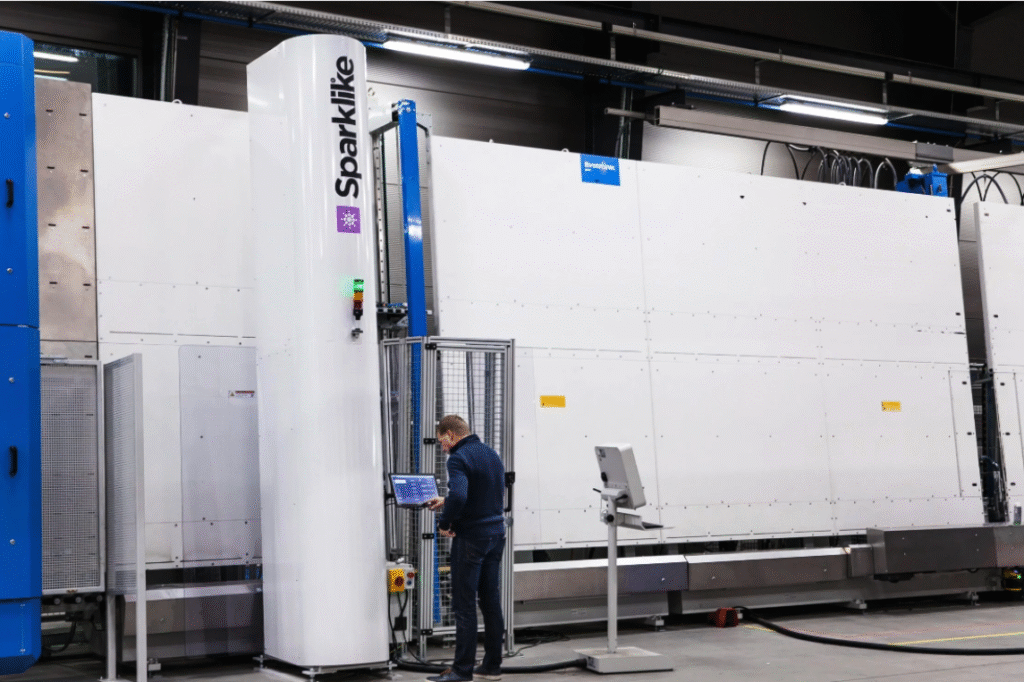This FAQ focuses on the four most widely used and internationally recognized methods for measuring gas concentration in insulating glass units (IGUs), explaining their principles, applications, and key differences.
What are the main methods for measuring gas concentration in insulating glass units (IGUs)?
In this section, we compare four established methods for determining gas fill levels in insulating glass units (IGUs).
- Plasma Emission Spectroscopy (PES) — non-destructive
- Paramagnetic Oxygen Method — destructive
- Gas Chromatography (GC) — destructive
- Laser Analysis (TDLAS) — non-destructive
These methods differ in accuracy, measurement conditions, and suitability for modern multi-cavity or coated IGUs.
1. How does Plasma Emission Spectroscopy (PES) work?
Type: Non-destructive
Use cases: Production lines, on-site inspections, basic double-glazed IGUs. Sparklike Handheld™ can measure through laminated glass, but only under certain conditions. Read more the conditions.
PES uses a high-voltage spark to ionize the gas inside the IGU cavity and analyses the emitted light to determine argon concentration.
Advantages
- Non-destructive
- Fast measurement
- Suitable for basic double glazing
Limitations
- Limited performance with thick glass, laminated IGUs, multi-cavity structures, or dual-coated IGUs
- Measurement range typically ~50–100% argon
Who uses it?
Manufacturers, quality control teams, and service technicians performing non-destructive argon measurements on production lines and on-site.
2. What is the paramagnetic oxygen method and when is it used?
Type: Destructive
Use cases: Factory auditing and certification testing
This method draws a gas sample from the IGU by puncturing the spacer. Since oxygen is strongly paramagnetic, its concentration is used to calculate the remaining inert gas (argon or krypton).
Advantages
- Widely used in national standards
- Suitable for certification testing
Limitations
- Destructive to the IGU
- Not suitable for finished products or installed windows
- Single-point sampling may produce variability
Typical threshold values:
- Initial gas content: ≥85%
- Post-aging durability requirement: ≥80%
3. Why is gas chromatography considered the most accurate method?
Type: Destructive
Use cases: Gas leakage rate testing, durability analysis, certification (EN 1279-3)
Gas chromatography separates and quantifies the gases extracted from the IGU cavity with micro-level precision.
Advantages
- Highest measurement accuracy in the industry
- Required for gas leakage rate verification under EN 1279-3
- Can detect extremely small gas losses (mg range)
Limitations
- Destructive
- Complex laboratory equipment
- High cost
- Not suitable for production lines or field inspections
Standard requirement:
Annual gas leakage rate must be ≤ 1% per year (EN 1279-3).
4. What is Laser Gas Analysis (TDLAS) and how does it differ from other methods?
Type: Non-destructive
Use cases: Modern IGU structures, field inspections, production automation
Laser analysis uses a tunable diode laser to measure the oxygen absorption signature inside the IGU. The oxygen level is then converted to inert gas concentration.
Advantages
- Fully non-invasive
- Works through low-E coatings, laminated glass, triple glazing
- Measures each cavity separately (Sparklike Laser devices)
- Provides glass thickness and cavity thickness simultaneously (Sparklike Laser devices)
- Can be automated on IGU production lines (Sparklike Laser Integrated)
- Accurate to ±2%. Read comparison of Sparklike Laser Portable to Gas Chromatography.
Limitations
- Not yet the formal reference method in EN 1279 for certification testing
Who uses it?
Manufacturers, consultants, auditors, and installers requiring fast, reliable, non-destructive gas measurement.

Are there other gas measurement technologies used in the industry?
Yes. In addition to PES, TDLAS, GC, and the paramagnetic oxygen method, the industry also uses technologies based on:
Thermal Conductivity
Used to measure argon or krypton concentration by analyzing heat transfer differences between gases.
- Requires a gas sample (destructive)
- Commonly used for spot checks and general QC
- Works with gas mixtures
Paramagnetic Oxygen Cells (alternative implementations)
Measures oxygen directly, then calculates inert gas content.
- Gas sampling required (destructive)
- Gas type does not need to be known
These technologies can be used in hand-operated or benchtop instruments for production quality control, but they require gas extraction and cannot be used on finished or installed units.
Which gas measurement method is best for daily IGU production quality control?
For routine QC of modern IGUs, non-destructive methods are preferred:
- Laser Analysis (TDLAS) — best for coated, laminated, triple-glazed, and multi-cavity units
- PES — suitable for simple double glazing on production lines
Destructive methods are mainly used in certification, laboratory studies, or standards compliance testing.
Which method is required by international IGU standards?
EN 1279-3 (Europe)
- Requires gas chromatography for leakage rate and concentration tolerances.
- Key Takeaways from EN 1279-3:2018
ASTM E2649 (USA)
- Defines procedures for plasma emission spectroscopy (non-destructive).
- How ASTM E2649-20 Supports Non-Destructive Measurement
GB/T 11944 (China)
- Specifies the paramagnetic oxygen method for initial and aged gas content.
- Allows non-destructive laser methods for field inspection.
- Read Sparklike’s blog post about GB/T 11944
JIS R 3224-3 (Japan)
- Aligns with EN 1279-3; gas chromatography is the reference.
- Read mora about JIS R 3224-3

Why should manufacturers prefer non-destructive gas measurement?
Non-destructive methods enable:
- 100% inspection of production
- No damage to the IGU or seal
- Verification after installation
- Reduced rework and customer complaints
- More stable production processes
- Traceability and documentation
- Compliance with internal quality assurance requirements
More information on Sparklike’s solutions and their applications in IGU quality control.
